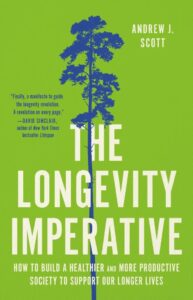
What Longer Lifespans Mean For Overall Human Health
Andrew J. Scott on Aging and Disease in the Modern World
In Greek mythology, the goddess Eos had a mortal lover, a Trojan named Tithonus. Eos asked Zeus to make Tithonus immortal but forgot to specify eternal youth. The result (given that Zeus had a mean streak) was that Tithonus lived forever while his body continued to age. According to Tennyson, “when loathsome old age pressed full upon him, and he could not move nor lift his limbs… she laid him in a room… there he babbles endlessly and no more has strength at all.”
The moral of the tale, of course, is to be careful what you wish for. Continuing to live while your body and mind fall to pieces is not an appetizing prospect. If lives are getting longer and your deepest fear is ending up like Tithonus, then focusing on the evergreen imperative to age well must be your priority.
A new era where the young grow up to become very old in large numbers is leading to a significant shift in society’s disease burden.
The fate of Tithonus lurks behind the narrative of an aging society. That is because a new era where the young grow up to become very old in large numbers is leading to a significant shift in society’s disease burden. When most of the population was young, and infant mortality was high, infectious diseases were the primary source of death.
But as more and more of us live to old age, the danger to health has shifted to noncommunicable diseases such as dementia, cancer, diabetes, arthritis and pulmonary and cardiac-related illnesses. According to the World Health Organization, seven of the top ten causes of global deaths (before Covid-19) were noncommunicable diseases, accounting for roughly three-quarters of all deaths.
Noncommunicable diseases have two features. The first is that the older you are the more likely you are to experience them. The second feature of noncommunicable diseases is that they tend to be chronic—in other words, they persist. Combine these two features and you get a third—the older you are, the more noncommunicable diseases you are likely to experience simultaneously (a condition known as “multi-morbidities”).
If we live for longer, inevitably we are more likely to experience age-related diseases. In the UK, the cancer charity CRUK estimates that someone born in 1930 had roughly a 33 percent chance of experiencing cancer in their lifetime, whereas for someone born in 1960, the chance was up to 50 percent. The charity Alzheimer’s Disease International calculates that every three seconds someone in the world develops dementia. That means while you read that sentence, two new cases were recorded. Already there are around 57 million people globally with dementia, the majority in low- and middle-income countries. That number is expected to increase to 153 million by 2050.
It is undoubtedly a welcome family outcome to have four living grandparents (and growing numbers of great-grandparents) but it may bring an uncomfortable burden. Around three-quarters of people living with dementia are cared for by their family. The US Alzheimer’s Association estimates that in 2010, 14 billion hours of unpaid care were provided by family members to their older relatives. Balancing family commitments with the demands of work and the need for leisure and other individual pursuits is becoming increasingly tricky for many people.
These unpleasant statistical realities cast a grim shadow over the prospect of getting old. But again, it’s important to look at the facts carefully. Doing so leads to a different perspective and perhaps even grounds for optimism.
Dementia is a horrible disease, and its rising incidence is a serious problem. But not everyone will suffer impaired cognitive skills. One study of European and North American data estimates that around one in ten people aged between eighty-five and eighty-nine years develops dementia. Those odds are concerning but still imply that nine out of ten people of that age won’t.
There are two related factors here that need to be considered separately. The first is the probability of experiencing a disease. It is a truism that the longer you live, the more likely you are to experience any disease over your lifetime, especially if it is age-related. It is this increasing risk brought on by longer lives that explains the rising incidence of both dementia and cancer. The other factor is your probability of suffering from a disease at any given age. Here there is good news. The risk of getting dementia at any particular age seems to be declining, by around 13 percent each decade. Because we are living longer we are more likely to experience dementia but at each age our risk of dementia has been falling. That is a powerful example of the malleability of age.
While more of our life is spent in good health, there has not been a reduction in the number of years in poor health.
Similarly, while the lifetime risk of cancer is increasing so are the survival rates for many forms. In the US, between 1975 and 2016 five-year survival rates improved for twenty-one out of twenty-four types of cancers. In 1975 only half of these cancers had a five-year survival rate above 50 percent; now, it’s 75 percent.
Not all the news is good. Another disease where age is a significant risk factor is type 2 diabetes. The disease resulting from the body’s ineffective insulin production has become one of the top ten causes of death globally and is estimated to double or triple mortality risk. Between 1990 and 2017, the global incidence of diabetes more than doubled. Around one in sixteen Brits and one in ten Americans are now diabetic.
Linked to this rise in diabetes is obesity—the body’s accumulation of excessive fat. In 2016 more than 650 million adults globally were estimated to be obese—nearly one in thirteen of the adult population. The worldwide prevalence of obesity is estimated to have tripled since 1975. It isn’t just among adults that this has occurred. In 1975 around one in twenty-five children aged between five and nineteen were obese. Now it’s nearly one in five.
So what are we to make of all these seemingly contradictory trends? Does living longer mean that on average we are healthier for longer? Or will we be living in poor health for longer? The good news is that the answer to the first question is yes. The bad news is that the answer to the second question is also yes. While more of our life is spent in good health, there has not been a reduction in the number of years in poor health. In other words, there has been an expansion rather than a compression of morbidity (years spent experiencing illness and disease).
That is because gains in overall life expectancy are currently out-stripping our capacity to remain healthier for longer, and means there is a new imperative to age well. It is why tackling age-related diseases is paramount for all of us, and why as individuals we need to think hard about exercise, sleep, stress and nutrition.
Governments need to think about a twenty-first-century public health initiative aimed at supporting healthy aging, especially given rising levels of obesity and the prevalence of diabetes. It also explains why the life sciences sector is getting ever more interested in developing treatments that help us age better. If our greatest fear is ending up like Tithonus, then it is obvious what our greatest priority should be. We must take evergreen steps to change how we age.
__________________________________

Excerpted from The Longevity Imperative: How to Build a Healthier and More Productive Society to Support Our Longer Lives, by Andrew J. Scott. Copyright © 2024. Available from Basic Books, an imprint of Hachette Book Group, Inc.
Andrew J. Scott
Andrew J. Scott is a professor of economics at London Business School, having previously taught at Oxford and Harvard University. He is cofounder of the Longevity Forum, a consulting scholar at the Stanford Center on Longevity, and coauthor of the global bestseller The 100-Year Life. He lives in London.



















